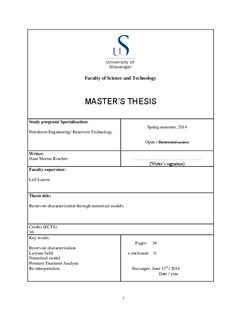| dc.contributor.author | Roscher, Hans Marius | |
| dc.date.accessioned | 2014-09-22T12:47:22Z | |
| dc.date.available | 2014-09-22T12:47:22Z | |
| dc.date.issued | 2014-06-16 | |
| dc.identifier.uri | http://hdl.handle.net/11250/220934 | |
| dc.description | Master's thesis in Petroleum engineering | nb_NO |
| dc.description.abstract | Numerical models have been generated for two DST’s run in the Ile and Tilje formations in the exploration wells 6406/2-2 and 6406/2-4SR in the Lavrans field located in the mid-Norwegian sea at Haltenbanken. DST 2 in well 6406/2-2 was run in March 1996, and DST 1 in well 6406/2-4SR in January 1999. Several models, with basis in geological maps, are made for each test and compared to geological data to confirm consistency. As part of the re-interpretation a series of numerical models were run for each test to recognize and understand formation properties near and around the wellbore.
The well 6406/2-4SR in the Tilje formation is found to be located in a complex formation with several permeable and impermeable faults and/or compartments surrounding the well. Two possible models are found to give a good match. One composite model with compartments of different permeability built outside the previous compartment. The second model is a flow channel going in circles around the well varying in width of the channel, also with several permeable and impermeable faults present in channel.
According to pressure trends all models show that well 6406/2-2 in the Ile formation is located in a truncated channel which is also consistent with geological map. The channel is easily located in the map but it is not as wide as the map indicates, only 160 ft wide, and 50 ft -80 ft north from the well an impermeable fault is present, sealing the channel in that end while it’s open in the south going direction. After 1050 ft the channel opens up towards the west.
Numerical models give a good indication of possible flow patterns or formation layouts in the reservoir due to the flexibility of the model. It allows modifying reservoir model condition to understand different behavior of pressure response. A composite model for 6406/2-2 DST 2 was run to show the flexibility of the numerical models and also underline how important it is to be critical when choosing models.
Lavrans has many isolated segments (compartments) due to tight faults and fractures combined with shale zones that isolate the sand layers. The same trend is observed through pressure transient analysis and numerical models run in Ecrin Kappa Saphire. Pressure transient tests and numerical models for all cases are generated in Ecrin Saphire. | nb_NO |
| dc.language.iso | eng | nb_NO |
| dc.publisher | University of Stavanger, Norway | nb_NO |
| dc.relation.ispartofseries | Masteroppgave/UIS-TN-IPT/2014; | |
| dc.rights | Attribution 3.0 Norway | * |
| dc.rights.uri | http://creativecommons.org/licenses/by/3.0/no/ | * |
| dc.subject | petroleumsteknologi | nb_NO |
| dc.subject | reservoir technology | nb_NO |
| dc.subject | numerical model | nb_NO |
| dc.subject | reservoir characterization | nb_NO |
| dc.subject | lavrans field | nb_NO |
| dc.subject | re-interpretation | nb_NO |
| dc.subject | reservoarteknologi | nb_NO |
| dc.title | Reservoir characterization through numerical models | nb_NO |
| dc.type | Master thesis | nb_NO |
| dc.subject.nsi | VDP::Technology: 500::Rock and petroleum disciplines: 510::Petroleum engineering: 512 | nb_NO |

